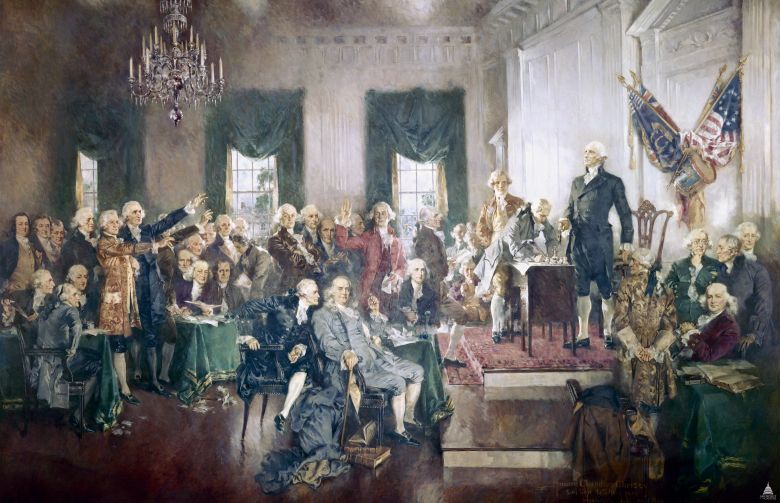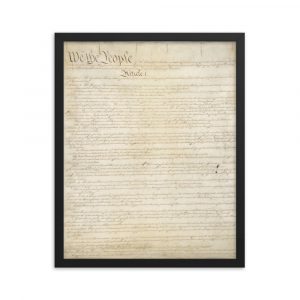When people study and talk about the American Revolutionary Period, they often focus on the battles or the central figures from the revolutionary movement. While the fights were important, one could argue that the political battles taking place in Philadelphia had a far more significant consequence on American history, and the world for that matter, that the Battles of Saratoga or the Battle of Bunker Hill. While there has been a greater focus on the era as of late with the smash Broadway hit Hamilton, it is often hard to push past the historical rose-colored glasses of figures such as Hamilton, Washington, etc. and get to the fight for this country. The actual battle over what this new country was to be, and how to form that country was far more interesting than the fictional cherry tree of Washington’s youth.
Colonists chaffed at the power being held in the hands of so few, and with growing animosity, the Colonies declared their independence in 1776. Ok, so they have declared independence, but what’s next? That’s the question that so many pondered in the Revolutionary Summer of 1776 and beyond. It is one thing to declare yourself free from the King of England, but if that form of government was being pushed aside, what was to replace it?
Understandably, the Founding Fathers of the United States had differing views of how the new country should be designed, but the overwhelming opinion was that a strong centralized government had no business in the new United States. In the early years of the war, there were conventions held to design the law of the new land. With an eye directly towards states’ rights, the Articles of Confederation were ratified in 1781, the same year that Cornwallis surrendered at Yorktown, giving this new country its independence.
There is no delicate way to put this, the first form of American government sucked, a lot. The Articles of Confederation was the first law of the land, and it was laughably inept. Based on a fear of strong, centralized, power, the Articles of Confederation left the Federal government incompetent. Many people may see this as an excellent thing as governments around the world continue to pry into our daily lives, but there needs to be a balance.
The Federal Government under the Articles of Confederation had no power, no money, and no way to raise money. The United States also didn’t have a standing Army after the end of the Revolution. It was this lack of military might that led to one of the most embarrassing events in the history of the Federal government, Shay’s Rebellion.
The rebels under Revolutionary War soldier Daniel Shays were angered by what they saw as unfair tax practices in Massachusetts and rebelled, eventually marching on the Arsenal at Springfield. There is an armed mob marching through the Massachusetts countryside, and the people are scared, they beg for state and Federal help. The Massachusetts Militia is called out, and the Federal government is asked to send troops, but they can’t. The Federal government was so broke and so disorganized that a ragtag group of farmers was allowed to march through and attack an arsenal.
This was the last straw, almost everyone could see by this point that the government needed to be changed, and a Constitutional Convention was called in 1787. There emerged two sides of the argument, the Federalists and the Anti-Federalists.
The Federalists
The Federalists saw the failures of the Articles of Confederation as a direct threat to the survival of the United States. Federalists wanted just as the name implies, a powerful centralized government that took much of the power away from the states. The original Federalist plan was not to include amendments or what became known as the Bill of Rights, and this view was championed by many of the most influential and famous founding fathers such as Alexander Hamilton, Benjamin Franklin and eventually George Washington.
The Anti-Federalists
Not to be cheeky, but they literally went against anything the Federalists held dear. Anti-Federalists saw the thought of a powerful centralized government as a direct threat to Civil Liberties and a callback to Colonial rule. The Anti-Federalists saw the Federalist’s reluctance to admit a Bill of Rights as the perfect example of the threats posed by a strong government. The most influential Anti-Federalists were, among others, John Hancock and Patrick Henry.
The two sides went to political war throughout the summer of ’87. The Convention was marked by two massive compromises that set the foundation of American government, and the course of American history, the Great Compromise, and the three-fifths compromise.
The Great Compromise is possibly the most significant political agreement in American History; it set the foundation for the way we live today. Under the new government, there were three branches, Executive, Legislative and Judicial. The fight was over the lawmakers or the legislative branch as it is known. Obviously, the large, rich states wanted all of the power, the small states of the north-east were ticked off about this. You must remember that everyone had to sign this new document into law if one state held out it could kill the new government.
With that danger hanging over their heads, the founding fathers went about doing what they did best, making backroom deals.
The two sides eventually strike a compromise; the legislative branch was to be broken into two houses, the House of Representatives with membership based on population, and the Senate with two members from each state. The little states were happy; the large states were happy, well at least a few of the large countries were delighted.
The elephant in the room, or the Wolf by the ears as Thomas Jefferson described it was slavery. The north did not need slavery, but the southern economy was wrapped around it. Once the Great Compromise was struck it was now time to decide how populations were counted, the south wanted their slaves counted towards their population, but the north saw the idiocy in this. How can someone be counted as part of the population if they don’t have any rights of a citizen?
The argument once again threatened to unravel the delicate peace of the new government. The north caved a bit; they allowed the south to count each slave as 3/5ths of a person, thus permitting slavery to continue in the land of the free, a mistake this country would pay for eight decades later.
The history of the American government is rich in compromise, victories, blunders, and everything in between.
The Constitutional Convention of 1787 created the foundation of the Federal government we live under still to this day, though I would argue and many would agree, the system of checks and balances has failed, our government is much larger than anything our Founding Fathers ever dreamed of.
Thank You For Reading This Far
As our gift to you for reading up on the US Constitution we are offering you an exclusive discount on our beautiful framed copies of the founding document of the United States. Take an extra 20% off our sale price using the discount code “READER” and hang this historic document on your wall:





